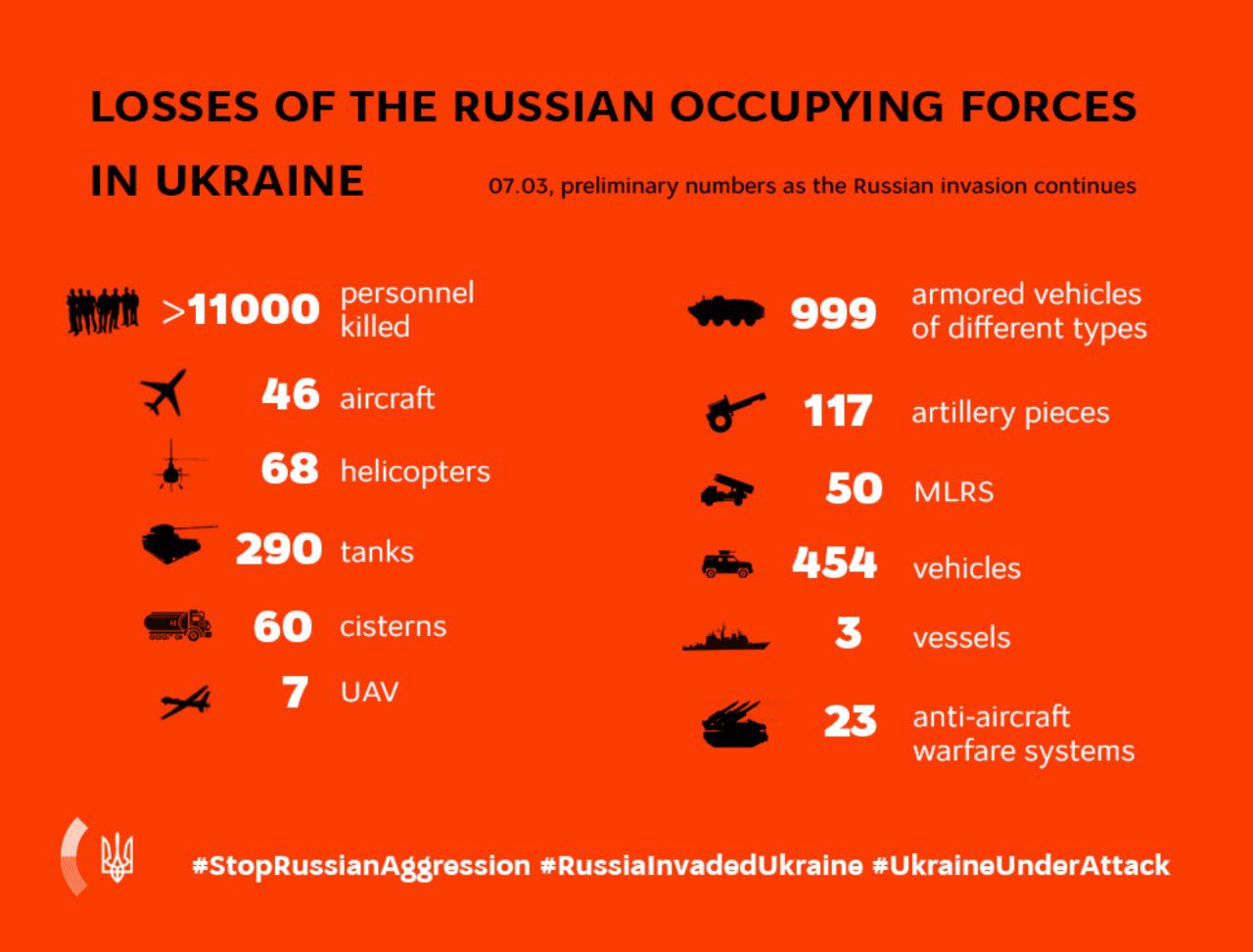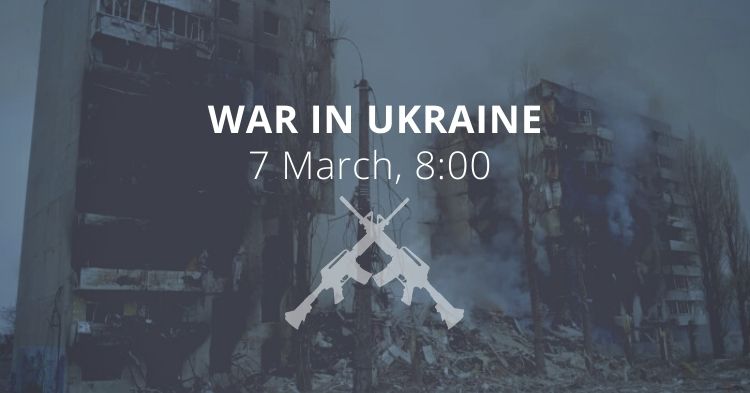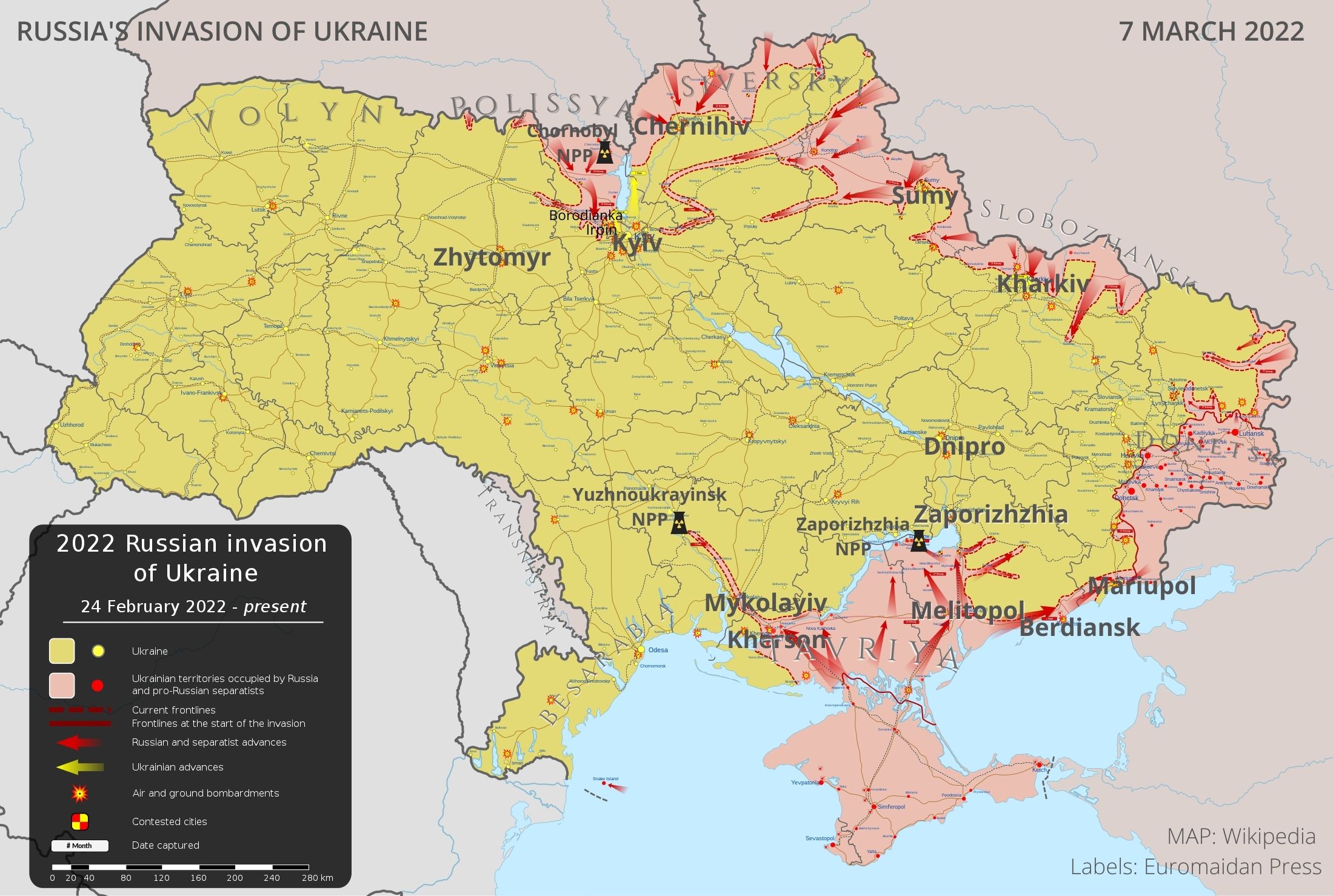Meanwhile, as the West continues to stand firm against introducing a no-fly zone in Ukraine, an Air Marshall says the West should be eying options to make such a zone a global coalition endeavor, rather than applying the NATO brand.
Morning report day 12 - March 7
The report is based on media reports, expert analyses and official information posted online.
Situation
According to information from the General Staff of Ukraine as of Operational information on 06.00, 07.03.2022 and [midnight]:
[The enemy continues the offensive operation against Ukraine, focusing on the encirclement of Kyiv, Kharkiv, Chernihiv, Sumy, and Mykolayiv, reaching the administrative borders in Luhansk and Donetsk oblasts, creating a land corridor with occupied Crimea in the direction of Mariupol - Novoazovsk.]
[The invaders did not achieve the ultimate goal of eleven days of occupation.]
[The enemy group began to accumulate resources for the storming of Kyiv.]
[At the same time, the occupiers did not stop trying to prepare for the offensive in the Polissya, Siversky, Donetsk, and Tavriya directions.]
[In the Polissya direction, the enemy is trying to establish full control over the cities of Bucha and Irpin and get closer to the capital of Ukraine.]
[In the area of the city of Irpin, the enemy is moving in tank and motorized infantry units.]
[From the territory of the Republic of Belarus through the Chornobyl Exclusion Zone the supply of fuel and other material means for the occupying forces continues.]
The invaders continue to use the airfield network of the Republic of Belarus to carry out airstrikes on Ukraine.
[In the northern direction, the occupiers are trying to provide a tactical advantage to reach the eastern outskirts of Kyiv through Brovarsky and Boryspil districts, as well as to establish control over the cities of Chernihiv and Sumy.]
[In the Tavriya direction, the occupiers are conducting an offensive with forces of up to three [Batallion Tactical Group] BTGs in the direction of the city of Zaporizhzhia. The enemy managed to restore the movement of trains on the Antonov railway bridge across the Dnieper.
[In addition, the advance of enemy units in the north-eastern direction along the Ingul River continues. BTGr forced the river and occupied settlement Kashpero-Mykolaivka.]
The Group of the Defence Forces of Ukraine carries out a defense operation in all areas of the enemy advance. The enemy continues to suffer heavy losses in manpower, ground equipment, and means of air attack. Surrenders to captivity.
[After the units of the Armed Forces of Ukraine inflicted fire damage on the places of accumulation of the enemy's weapons in the areas of Nova Basan and Skripali, the enemy suffered significant losses, redeployed additional forces to replenish manpower and equipment.]
[The [Ukrainian] Defense Forces continues to conduct a defense operation in the South, East, and North. In the course of hostilities, the city of Chuhuiv was [in the Kharkiv region] liberated. The occupiers suffered heavy losses in personnel and equipment. Lieutenant Colonel Dmitry Safronov, Commander of the 61st Separate Marine Brigade of the Russian Armed Forces, and Lieutenant Colonel Denis Glebov, Deputy Commander of the 11th Separate Airborne Assault Brigade of the Russian Armed Forces, were killed.”
(In the Luhansk direction, Ukrainian soldiers were firmly holding their positions [midnight], inflicting losses on the enemy. According to the General Staff, they made several successful counterattacks. As a result, the occupiers lost about 40 personnel, 8 infantry fighting vehicles, 1 MTLB, a Ural truck, an SUV, and artillery systems (number to be determined).)
.@Nrg8000 has made a timelapse map showing gains of Russian invaders since the start of the full-blown war against Ukrainepic.twitter.com/AdjiOOog2f
— Euromaidan Press (@EuromaidanPress) March 7, 2022
Russia is probably targeting Ukraine’s communication infrastructure to reduce access to reliable news sources, Britain’s Ministry of Defence has said, Aljazeera reports.
“Russia is probably targeting Ukraine’s communications infrastructure to reduce Ukrainian citizens’ access to reliable news and information,” a defence intelligence update posted on Twitter said.
According to the media:
- Vinnytsia - the Russians sent 8 missiles against Vinnytsia, after which Zelensky once again called on Western countries to close the airspace over the state.

Humanitarian
More than 1.5 million Ukrainian refugees have arrived in neighbouring countries since Russia launched its unprovoked invasion of Ukraine, according to UN refugee agency data on Sunday.
United Nations aid agencies have warned that fuel, cash and medical supplies were dwindling in Ukraine, which could lead up to 5 million people to flee the country, Reuters reports. "At this rate, the situation looks set to become Europe’s largest refugee crisis this century, and UNHCR is mobilizing resources to respond as quickly and effectively as possible," the UN refugee agency said.
Hundreds of thousands of Ukrainians in dozens of settlements need immediate evacuation. According to the President’s Office, the humanitarian situation is catastrophic in several dozen cities, and their number is growing every day. The President's Office has released a complete list of cities and regions in need of immediate evacuation:
- Sumy region (directions Sumy, Shostka, Romny, Konotop, Okhtyrka)
- Chernihiv region (eastern and northern parts of the region)
- Kharkiv region (all region, except the south-eastern part)
- Kyiv region (Bucha, Irpin, Vyshhorod, Ivankiv, Vasylkiv, Borodyanka)
- Mykolaiv region (Bashtansky, Snigurov, Bereznehuvatsky directions)
- Zaporizhzhia region (Tokmatsky, Berdiansk, Velykobilozersky directions)
- Kherson region (Chaplynka, Kalanchak, Henichesky and Novokakhovsky directions)
- Luhansk and Donetsk regions.
According to Ukrainska Pravda:
- Chernihiv Oblast - the enemy is shelling the outskirts of the city, fighting is going on, hot in the Nizhyn direction. Chernihiv region received humanitarian aid with medicines and food. All this is immediately distributed among medical institutions, retail chains, volunteer centers, because the enemy, as it was in previous days, is trying to carry out airstrikes on aid centers.
- Evacuations of civilians were planned in Luhansk and Donetsk oblasts, but in the Donetsk Oblast, the green corridor from Mariupol was blocked by Russian shelling. Kramatorsk was also shelled. In the Luhansk Oblast, the enemy fired on houses in the town of Rubizhne.
- Sumy Oblast - after the shelling by the Russians, part of the region remains without heat. Near Lebedyn, the CHP was destroyed, Trostyanets was almost de-energized; in total, in the area, about 10 thousand subscribers remain without light. In total, the region received 6 trucks of humanitarian aid from the Poltava region.
- Rivne Oblast - 15 tons of aid were unloaded, including medicines, products, household chemicals, which will be sent to the places where people need them the most.
Legal
As a testimony of both Ukrainian resilience and sacrifices in the face of Russian warfare, as well as the extent of the latter’s extensive attack on civilian areas, president Zelenskyy has awarded Volnovakha, Gostomel, Mariupol, Kharkiv, Kherson, and Chernihiv the honorary award "Hero City of Ukraine."
The General Staff of Ukraine reports that
“From the beginning of the day, the Russian occupier continued to carry out rocket-bomb and artillery strikes on settlements in Ukraine. Acting insidiously, the occupiers violate the rules of international humanitarian law, shell civilians, "green corridors", take women and children hostage, place equipment, ammunition in residential areas of cities, artificially create a humanitarian crisis in the occupied settlements. The city of Irpin remains deprived of light, water and heat for more than three days, there is no supply of food and water, the occupiers forbade citizens to leave their homes.
There are numerous cases of staging reports for Russian TV channels about the alleged humanity and humanity of the [Russian] soldiers. Also, on social networks, the enemy continues to distribute the content created [ ] which negatively covers the activities of the Armed Forces of Ukraine.”
There is a loud and growing chorus of calls for the International Criminal Court to pursue Vladimir Putin. On Wednesday, the court said it would immediately proceed with an active investigation of possible war crimes following Russia's invasion of Ukraine, CNN reported 4 March. The US Embassy in Kyiv said on Friday that Russia committed a war crime by attacking a nuclear power plant in Ukraine. Its suspected use of cluster bombs and so-called vacuum bombs in dense areas with many civilians has also been described as a war crime.
Environmental
“The conflict in Ukraine is expected to send food prices spiking in an already volatile food market where prices had spiked to their highest in more than a decade. But it’s not the first time. In 2020, during the early days of the pandemic, Russia ceased grain exports just like it had done a decade before after drought and wildfire devastated its agricultural sector. Both of those episodes increased grain prices around the world,” Green Queen reports.
“The crisis comes at a moment when international food markets are already struggling with soaring prices and the continuing fallout from the COVID-19 pandemic,” said Adriana Herrera, chair of the Agricultural Market Information System (AMIS) of the G20 countries
. “Apart from causing humanitarian hardship in the region itself, the crisis risks jeopardizing the food security of millions of people around the world who depend on affordable food from international markets for their daily subsistence.”
Support
In less than a week, the United States and NATO have pushed more than 17,000 antitank weapons, including Javelin missiles, over the borders of Poland and Romania, the New York Times report.
“But those are only the most visible contributions. Hidden away on bases around Eastern Europe, forces from United States Cyber Command known as “cybermission teams” are in place to interfere with Russia’s digital attacks and communications — but measuring their success rate is difficult, officials say. In Washington and Germany, intelligence officials race to merge satellite photographs with electronic intercepts of Russian military units, strip them of hints of how they were gathered, and beam them to Ukrainian military units within an hour or two.”
The German “Bild” points out that Europe continues to buy Russian gas and is, therefore, indirectly helping to finance Putin's war in Ukraine. It asks:
"Can it stay like this? 60% think that Germany should stop buying Russian gas (28% don't want that). To compensate for the loss of Russian gas, 59% are in favor of extending the remaining nuclear power plants in Germany (to be shut down at the end of the year). The reason for the increased willingness to impose sanctions is that most Germans fear a further escalation of the war. 77% are concerned that nuclear weapons could be used. 76% fear that Russia could attack other countries besides Ukraine."
The German Minister of Foreign Affairs, Annalena Burbock, yesterday reiterated that NATO will not close its airspace over Ukraine. She argues that "It will mean that NATO planes will fire on Russian planes, it will mean NATO's direct involvement in the conflict…”. She noted that the bloc is responsible for the lives of millions of Europeans and cannot risk Putin's war in Ukraine spreading to other countries and becoming a third world war, so "we must keep a cool head."
“Close the sky!” or how Russia bombed out my town of Borodyankahttps://t.co/Cjz9ZfLTEY#NoFlyZoneOverUkraine#StopPutinNOW pic.twitter.com/R9brdRi9R4
— Euromaidan Press (@EuromaidanPress) March 6, 2022
This view is probably shared among most NATO members. According to the New York Times,
“members of Congress on Sunday emphasized what has become a widely held position on Capitol Hill: that the United States should respond to Russia’s invasion of Ukraine by banning Russian oil imports, but not by imposing a no-fly zone over the country that could draw nuclear powers into war.”
In an interview with CBS News, US Secretary of State, Antony Blinken, said that Poland has the ‘green light’ to send fighter jets to Ukraine, while the United States and other allies are increasing their support for Ukraine’s defense. Currently, the United States is talking with Poland about backfilling its needs if Poland chooses to provide fighter jets to the Ukrainians. According to a US spokesperson, sending fighter jets into Ukraine is a “sovereign decision for any country to make” and noted there are a host of logistics to work through, including how the aircraft would be transferred from Poland to Ukraine. However, the proposal is subject to uncertainty since Polish support for the Ukrainian air force will be perceived in Moscow as participation in the conflict and might trigger retaliation
.
Congress is expected to “pass a $10 billion emergency spending bill this week to provide more arms and humanitarian assistance to Ukraine, in response to requests by Ukrainian officials for additional support”, the New York Times report.
“The $10 billion proposal includes $4.8 billion in additional funds for the Pentagon to cover the deployment of US troops to NATO countries, increased intelligence and cybersecurity support and to replenish the weapons the Defense Department has already sent to Ukraine, such as Stinger missiles. It also includes $4.25 billion in new funding for economic and humanitarian assistance for Ukrainians, including the 1.5 million refugees who have already fled from the bombarded nation.”
On March 6 while moving towards Mykolaiv the armored car of Swiss journalist Guillaume Bricket was fired at by Russian forces. The car was marked “Press”. As a result, several bullets hit the glass, injuring the foreigner. According to the National Police, the journalist suffered facial and forearm injuries. After the vehicle was stopped, the Russian invaders confiscated the citizen's documents, money, photographic, video equipment, laptop, and other valuables and released him.
New developments
According to the Centre for Defence Strategies:
- The US Secretary of State and the Minister of Foreign Affairs of Ukraine met on the Ukrainian-Polish border. The key topics were: the transfer to Ukraine, primarily from Poland, of Soviet and Russian-made jet fighters, which should immediately strengthen Ukraine's defense capabilities.
- The British Prime Minister has put forward a 6-point plan towards Russia, which includes joining the international community's efforts in humanitarian support for Ukraine, stabilization of the defense and strengthening the resilience of the Allies, increasing economic pressure on Moscow, preventing "creeping normalization" of Russia's actions in Ukraine, a diplomatic settlement exclusively with the participation of the legitimate government of Ukraine. The British Prime Minister is trying to give additional impetus to the support of Ukraine and its structuring, which completely coincides with the intentions of Ukraine.
Assessments
The Pentagon estimates that there has been no significant change in the balance of power in Ukraine over the weekend, Radio Szczecin reports.
“Although the Russians bombard civilians and try to surround the cities in the north of Ukraine, they face strong resistance.”
“On Sunday, the Russians continued artillery and rocket firing at Ukrainian cities, also in areas inhabited by civilians. The Pentagon estimates that more than 600 Russian rockets have been dropped on Ukraine since the beginning of the war. The Russians, however, did not capture significant territory over the weekend. Although they try to surround Kyiv and Kharkiv, they encounter strong resistance from the Ukrainians. The 60-kilometer Russian military convoy is still standing north of Kyiv. According to the Pentagon, 95% of the Russian forces at the borders have already entered Ukraine.”
The Russians did not achieve airspace domination either. Ukrainian planes still fly, and air defense systems are in operation. However, the US Department of Defence is not able to verify the information provided by the Ukrainian side on the number of Russian machines knocked down.”
In an article in King’s College, Air Marshal Greg Bagwell, Former RAF Commander of Operations, argues that
Once the authority is clearly established, the mandate and “rules” would need to be clearly communicated to make it very clear what is expected of Russia and what would be the consequences. To be crystal clear, any hostile aircraft making an incursion into Ukrainian airspace would be engaged; however, to further avoid escalation, the [Rules of Engagement] ROE may have to be relatively restrictive otherwise.
For example, whilst hostile ground-based systems could and would be targeted, this could be restricted to those on Ukrainian soil only. This clearly results in the potential for longer range systems based in Russia/Belarus to target enforcing aircraft, however, this could be minimized through tactics, use of 5th Generation aircraft in more exposed areas, and, in any event, Russian missteps so far suggest these systems may not be as deadly as the marketing brochure suggests. But with these controls in place, it would be entirely reasonable to describe the NFZ as defensive in nature.
[ ] It is impossible to cover every facet of the operation in this short article but I believe that there is sufficient merit in the benefits and practicalities of implementation of an NFZ that it should be firmly on the table for discussion. The most disappointing aspect of the debate so far is that we have done exactly what Putin thought we would do, and if we aren’t going to change his calculus now, then when?
I fear that the opportunity to establish an NFZ is fast receding and that if the situation worsens into a humanitarian crisis and a prolonged siege of major cities, we will be completely impotent. It would appear that we have much to relearn on conventional deterrence vs nuclear escalation in the context of Russia – if the West can’t stomach that debate now, it better get an appetite quickly because next time we might not be able to hide behind Charters.


